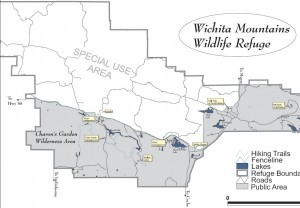From the 1986 edition of A Guide to Birding in Oklahoma published by the Tulsa Audubon Society. This account was updated in 2007.
The 59,020 acre Refuge was established in 1901 and hosts a rare piece of the past – a remnant mixed grass prairie, an island where the natural grasslands escaped destruction because the rocks underfoot defeated the plow.
The Refuge provides habitat for large native grazing animals such as American bison, Rocky Mountain Elk, and white-tailed deer. Texas longhorn cattle also share the Refuge rangelands as a cultural and historical legacy species. More than 50 mammal, 240 bird, 64 reptile and amphibian, 36 fish, and 806 plant species thrive on this important refuge.
From I-44 take Highway 49 (exit 45). Go west 10 miles to the Refuge gate. If coming from Highway 62, take Highway 115 (Cache exit) north to the Refuge Gate. You will find leaflet dispensers inside each of the Refuge gates that have maps and information.
The largest breeding population of the endangered Black-capped Vireo and the greatest amount of suitable habitat in the State of Oklahoma occurs on the refuge. Throughout its original historical breeding range from Kansas south to central Texas, the vireo population declined drastically primarily due to nest parasitism by the Brown-headed cowbird and secondarily to the loss of suitable nesting habitat. Current management includes annual monitoring of nesting success and population size, trapping and removal of Brown-headed cowbirds from the nesting area, and the utilization of prescribed fire to enhance or create oak shrubbery of a suitable height for preferred nesting sites. Research is ongoing to identify and map nesting territories and to document population size and nesting success.
The Refuge Visitor Center is located at the junction of State Highways 115 and 49. Dioramas and hands-on exhibits compliment artwork, sculptures and taxidermy within the22,000 sq. ft. facility. The four major habitat types, Rocklands, Aquatic, Mixed-grass Prairie and Cross Timbers, are highlighted. A night exhibit reveals the sounds after dark, while a history rail overlooks the scenery of the mountains from picture windows. Thes taff shows programs throughout the day in the 112-seat auditorium. There is no fee for entering the center. A bookstore/giftshop also is located in the center. Closed Tuesdays; hours 10:00am – 5:30 pm.
Trails:
Dog Run Hollow — A three-loop trail complex with trailheads at Dog Run Hollow, French Lake, Boulder Picnic Area and Lost Lake Picnic Area. From the French Lake trailhead, hikers can choose either the Elk Trail (1 mile), LonghornTrail (2 miles), or Buffalo Trail (5 miles). The Kite Trail (1.5 miles) between Lost Lake Picnic Area and Boulder Picnic Area allows hikers access to the Buffalo Trail loop by a stream crossing.
Elk Mountain Trail — The four mile trail leading around the west end of Elk Mountain meanders from Sunset Picnic Area to Post Oak/Treasure Lake parking area. A side trail from Sunset Picnic Area leads to the top of Elk Mountain. Trailheads at Sunset Picnic Area and Post Oak Lake are marked by trail maps and information signs.
Little Baldy Mountain Trail — A 1.5 mile trail along the western edge of Quanah Parker Lake with a side trail leading to the top of Little Baldy Mountain. The trail may be taken from Quanah Parker Environmental Education Center or the Quanah Parker Dam.
Environmental Education Interpretive Trail — a .25-mile handicapped accessible trail with exposed gravel surface concrete sidewalks and interpretive signs. Access is from the Quanah Parker Environmental Education Center parking lot. Handicapped visitors may use this trail for fishing access at Quanah Parker Lake. Handicapped parking is designated.
Birding the Refuge
Lake Elmer Thomas
Drive 2.5 miles west of Medicine Park on SH 49 to the Mount Scott Campground. Enter the campground on the first road on the left. Park cars; then walk south to the lake from the easternmost restrooms, or drive to the second set of restrooms and follow on foot the old graveled road, now closed to vehicular traffic.
This is an area of riparian deciduous forest, mostly black willow and buttonbush interspersed with some red cedar, ash, and pecan. The surrounding granite ridges are covered with scattered stands of post oak, blackjack oak, and little bluestem prairie.
In spring and summer Mississippi Kites are common birds of prey. During fall and winter waterfowl are plentiful: Gadwall, American Wigeon, Green and Blue-winged teal, Wood Duck and others. Turkey Vultures roost in large trees near the north shore in summer.
Other birds seen in the area are the American Woodcock (rare) in winter; Hermit Thrush, Swainson’s Thrush, Ovenbird, Yellowthroat, and American Redstart in spring. On nearby Mount Scott, one can usually see Canyon Wrens, Rock Wrens, and Rufous-crowned Sparrows most of the year.
Several species new to the Wichita Mountains Refuge list have been seen here in the past few years, especially during spring migration. It is well-sheltered, thus attractive to waterfowl. Spring is the best season, early morning the best time of day, and walking the best way to see the birds.
Elk Mountain Trail
This is a good location to find the Black-capped Vireo. Occasionally one may be heard or seen near the picnic area, but usually one will need to take the trail about one-quarter mile or so to find them. Canyon and Rock Wrens, Lesser Goldfinch and Rufous-crowned Sparrows are also found in this area.

